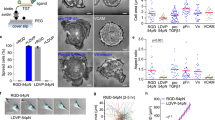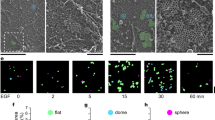Abstract
Receptors of the integrin family are expressed by every cell type and are the primary means by which cells interact with the extracellular matrix. The control of integrin expression affects a wide range of developmental and cellular processes, including the regulation of gene expression, cell adhesion, cell morphogenesis and cell migration1,2,3. Here we show that the concentration of substratum-bound ligand (laminin) post-translationally regulates the amount of receptor (α6β1 integrin) expressed on the surface of sensory neurons. When ligand availability is low, surface amounts of receptor increase, whereas integrin RNA and total integrin protein decrease. Ligand concentration determines surface levels of integrin by altering the rate at which receptor is removed from the cell surface. Furthermore, increased expression of integrin at the cell surface is associated with increased neuronal cell adhesion and neurite outgrowth. These results indicate that integrin regulation maintains neuronal growth-cone motility over a broad range of ligand concentrations, allowing axons to invade different tissues during development and regeneration.
This is a preview of subscription content, access via your institution
Access options
Subscribe to this journal
Receive 51 print issues and online access
$199.00 per year
only $3.90 per issue
Buy this article
- Purchase on Springer Link
- Instant access to full article PDF
Prices may be subject to local taxes which are calculated during checkout



Similar content being viewed by others
References
Reichardt, L. F. & Tomaselli, T. J. Extracellular matrix molecules and their receptors. Annu. Rev. Neurosci. 14, 531–570 (1991).
Letourneau, P. C., Condic, M. L. & Snow, D. M. Interactions of developing neurons with the extracellular matrix. J. Neurosci. 14, 915–928 (1994).
Clark, E. A. & Brugge, J. S. Integrins and signal transduction pathways: the road taken. Science 268, 233–239 (1995).
McCarthy, J. B. & Furcht, L. T. Laminin and fibronectin promote the haptotactic migration of B16 mouse melanoma cells in vitro. J. Cell Biol. 98, 1474–1480 (1984).
Arroyo, A. G. et al. Regulation of the VLA integrin-ligand interactions through the beta 1 subunit. J. Cell Biol. 117, 659–670 (1992).
Duband, J. L., Dufour, S., Yamada, S. S., Yamada, K. M. & Thiery, J. P. Neural crest cell locomotion induced by antibodies to beta 1 integrins. A tool for studying the roles of substratum molecular avidity and density in migration. J. Cell Sci. 98, 517–532 (1991).
Goodman, S. L., Risse, G. & von der Mark, K. The E8 subfragment of laminin promotes locomotion of myoblasts over extracelular matrix. J. Cell Biol. 109, 799–809 (1989).
Palechek, S. P., Loftus, J. C., Ginsberg, M. H., Lauffenbruger, D. A. & Horwitz, A. F. Integrin–ligand binding properties govern cell migration speed through cell–substratum adhesiveness. Nature 385, 537–540 (1997).
Rogers, S. L., Edson, K. J., Letourneau, P. C. & McLoon, S. C. Distribution of laminin in the developing peripheral nervous system of the chick. Development 113, 429–435 (1986).
Buettner, H. M. & Pittman, R. N. Quantitative effects of laminin concentration on neurite outgrowth in vitro. Dev. Biol. 145, 266–276 (1991).
Hynes, R. O. Integrins: versatility, modulation, and signaling in cell adhesion. Cell 69, 11–25 (1992).
Song, W. K., Wang, W., Foster, R. F., Bielser, D. A. & Kaufman, S. J. H36-alpha 7 is a novel integrin α chain that is developmentally regulated during skeletal myogenesis. J. Cell Biol. 117, 643–657 (1992).
Tomaselli, K. J. et al. Expression of beta 1 integrins in sensory neurons of the dorsal root ganglion and their functions in neurite outgrowth on two laminin isoforms. J. Neurosci. 13, 4880–4888 (1993).
Venstrom, K. & Reichardt, L. Beta 8 integrins mediate interactions of chick sensory neurons with laminin-1, collagen IV, and fibronectin. Mol. Biol. Cell 6, 419–431 (1995).
Weaver, C. D., Yoshida, C. K., de Curtis, I. & Reichardt, L. F. Expression and in vitro function of beta 1-integrin laminin receptors in the developing avian ciliary ganglion. J. Neurosci. 15, 5275–5285 (1995).
Bretscher, M. S. Circulating integrins: alpha 5 beta 1, alpha 6 beta 4 and Mac-1, but not alpha 3 beta 1, alpha 4 beta 1 or LFA-1. EMBO J. 11, 405–410 (1992).
Lawson, M. A. & Maxfield, F. R. Ca2+- and calcineurin-dependent recycling of an integrin to the front of migrating neutrophils. Nature 376, 75–79 (1995).
Regen, C. M. & Horwitz, A. F. Dynamics of beta 1 integrin-mediated adhesive contacts in motile fibroblasts. J. Cell Biol. 119, 1347–1359 (1992).
Gaietta, G., Redelmeier, T. E., Jackson, M. R., Tamura, R. N. & Quaranta, V. Quantitative measurement of alpha 6 beta 1 and alpha 6 beta 4 integrin internalization under cross-linking conditions: a possible role for alpha 6 cytoplasmic domains. J. Cell Sci. 107, 3339–3349 (1994).
Sibley, D. R., Benovic, J. L., Caron, M. G. & Lefkowitz, R. J. Regulation of transmembrane signaling by receptor phosphorylation. Cell 48, 913–922 (1987).
Damsky, C. H. & Werb, Z. Signal transduction by integrin receptors for extracellular matrix: Cooperative processing of extracellular information. Curr. Opin. Cell Biol. 4, 772–781 (1992).
Sastry, S. K. & Horwitz, A. F. Adhesion-growth factor interactions during differentiation: An integrated biological response. Dev. Biol. 180, 455–467 (1996).
Dai, J. & Sheetz, M. P. Axon membrane flows from the growth cone to the cell body. Cell 83, 693–701 (1995).
Craig, A. M., Wyborski, R. J. & Banker, G. Preferential addition of newly synthesized membrane protein at axonal growth cones. Nature 375, 592–594 (1995).
Bretscher, M. S. Moving membrane up to the front of migrating cells. Cell 85, 465–467 (1996).
Gomez, T. M. & Letourneau, P. C. Filopodia initiate choices made by sensory neuron growth cones at laminin/fibronectin borders in vitro. J. Neurosci. 14, 5959–5972 (1994).
de Curtis, I., Quaranta, V., Tamura, R. N. & Reichardt, L. F. Laminin receptors in the retina: sequence analysis of the chick integrin alpha 6 subunit. Evidence for transcriptional and posttranslational regulation. J. Cell Biol. 113, 405–416 (1991).
Vekeman, S., Jaspers, M. & Cassiman, J. J. Inhibition of the degradation of the precursor and of the mature beta 1 integrin subunit by different protein synthesis inhibitors and by ATP depletion. FEBS Lett. 327, 207–212 (1993).
Hotchin, N. A., Gandarillas, A. & Watt, F. M. Regulation of cell surface beta 1 integrin levels during keratinocyte terminal differentiation. J. Cell Biol. 128, 1209–1219 (1995).
Acknowledgements
We thank L. F. Reichardt for integrin antibodies and cDNA, and H. J. Yost and J. F. Challocombe for suggestions on the manuscript. This work was supported by grants from the NIH and the Minnesota Medical Foundation to P.C.L. and the Spinal Cord Research Foundation to M.L.C.
Author information
Authors and Affiliations
Corresponding author
Rights and permissions
About this article
Cite this article
Condic, M., Letourneau, P. Ligand-induced changes in integrin expression regulate neuronal adhesion and neurite outgrowth. Nature 389, 852–856 (1997). https://doi.org/10.1038/39878
Received:
Accepted:
Issue Date:
DOI: https://doi.org/10.1038/39878
This article is cited by
-
Attenuated GABAergic Signaling in Intestinal Epithelium Contributes to Pathogenesis of Ulcerative Colitis
Digestive Diseases and Sciences (2017)
-
Epac1 interacts with importin β1 and controls neurite outgrowth independently of cAMP and Rap1
Scientific Reports (2016)
-
Neural Regenerative Strategies Incorporating Biomolecular Axon Guidance Signals
Annals of Biomedical Engineering (2012)
-
Bidirectional remodeling of β1-integrin adhesions during chemotropic regulation of nerve growth
BMC Biology (2011)
-
Asymmetric endocytosis and remodeling of β1-integrin adhesions during growth cone chemorepulsion by MAG
Nature Neuroscience (2010)
Comments
By submitting a comment you agree to abide by our Terms and Community Guidelines. If you find something abusive or that does not comply with our terms or guidelines please flag it as inappropriate.




